Alessandra Pascale
Comprehensiveness Metrics for Automatic Evaluation of Factual Recall in Text Generation
Oct 09, 2025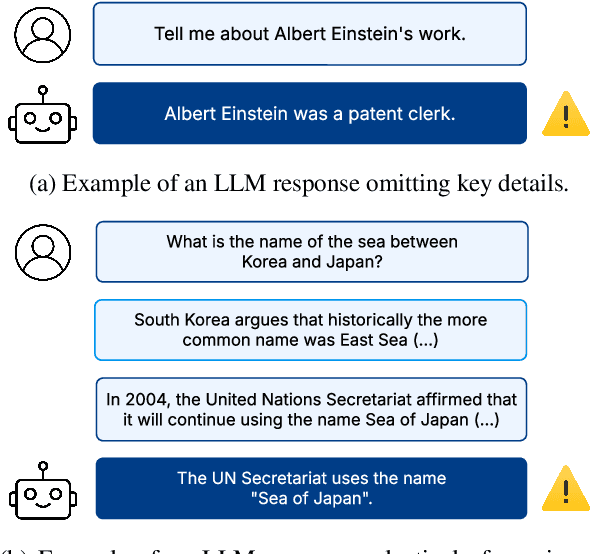
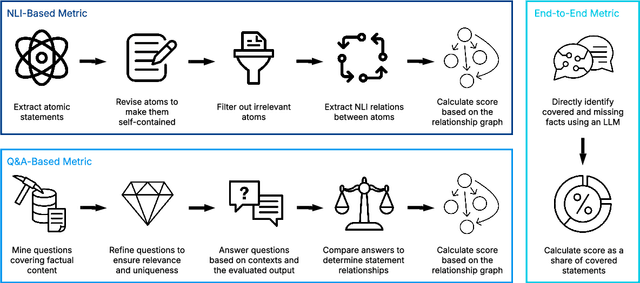
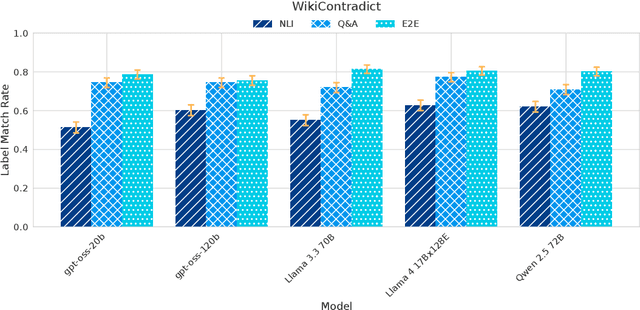
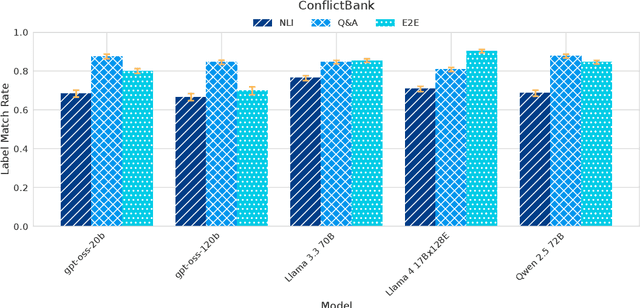
Abstract:Despite demonstrating remarkable performance across a wide range of tasks, large language models (LLMs) have also been found to frequently produce outputs that are incomplete or selectively omit key information. In sensitive domains, such omissions can result in significant harm comparable to that posed by factual inaccuracies, including hallucinations. In this study, we address the challenge of evaluating the comprehensiveness of LLM-generated texts, focusing on the detection of missing information or underrepresented viewpoints. We investigate three automated evaluation strategies: (1) an NLI-based method that decomposes texts into atomic statements and uses natural language inference (NLI) to identify missing links, (2) a Q&A-based approach that extracts question-answer pairs and compares responses across sources, and (3) an end-to-end method that directly identifies missing content using LLMs. Our experiments demonstrate the surprising effectiveness of the simple end-to-end approach compared to more complex methods, though at the cost of reduced robustness, interpretability and result granularity. We further assess the comprehensiveness of responses from several popular open-weight LLMs when answering user queries based on multiple sources.
Forging Time Series with Language: A Large Language Model Approach to Synthetic Data Generation
May 21, 2025Abstract:SDForger is a flexible and efficient framework for generating high-quality multivariate time series using LLMs. Leveraging a compact data representation, SDForger provides synthetic time series generation from a few samples and low-computation fine-tuning of any autoregressive LLM. Specifically, the framework transforms univariate and multivariate signals into tabular embeddings, which are then encoded into text and used to fine-tune the LLM. At inference, new textual embeddings are sampled and decoded into synthetic time series that retain the original data's statistical properties and temporal dynamics. Across a diverse range of datasets, SDForger outperforms existing generative models in many scenarios, both in similarity-based evaluations and downstream forecasting tasks. By enabling textual conditioning in the generation process, SDForger paves the way for multimodal modeling and the streamlined integration of time series with textual information. SDForger source code will be open-sourced soon.
Query-driven Document-level Scientific Evidence Extraction from Biomedical Studies
May 09, 2025Abstract:Extracting scientific evidence from biomedical studies for clinical research questions (e.g., Does stem cell transplantation improve quality of life in patients with medically refractory Crohn's disease compared to placebo?) is a crucial step in synthesising biomedical evidence. In this paper, we focus on the task of document-level scientific evidence extraction for clinical questions with conflicting evidence. To support this task, we create a dataset called CochraneForest, leveraging forest plots from Cochrane systematic reviews. It comprises 202 annotated forest plots, associated clinical research questions, full texts of studies, and study-specific conclusions. Building on CochraneForest, we propose URCA (Uniform Retrieval Clustered Augmentation), a retrieval-augmented generation framework designed to tackle the unique challenges of evidence extraction. Our experiments show that URCA outperforms the best existing methods by up to 10.3% in F1 score on this task. However, the results also underscore the complexity of CochraneForest, establishing it as a challenging testbed for advancing automated evidence synthesis systems.
FactReasoner: A Probabilistic Approach to Long-Form Factuality Assessment for Large Language Models
Feb 25, 2025


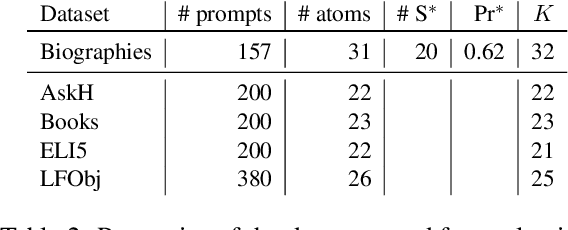
Abstract:Large language models (LLMs) have demonstrated vast capabilities on generative tasks in recent years, yet they struggle with guaranteeing the factual correctness of the generated content. This makes these models unreliable in realistic situations where factually accurate responses are expected. In this paper, we propose FactReasoner, a new factuality assessor that relies on probabilistic reasoning to assess the factuality of a long-form generated response. Specifically, FactReasoner decomposes the response into atomic units, retrieves relevant contexts for them from an external knowledge source, and constructs a joint probability distribution over the atoms and contexts using probabilistic encodings of the logical relationships (entailment, contradiction) between the textual utterances corresponding to the atoms and contexts. FactReasoner then computes the posterior probability of whether atomic units in the response are supported by the retrieved contexts. Our experiments on labeled and unlabeled benchmark datasets demonstrate clearly that FactReasoner improves considerably over state-of-the-art prompt-based approaches in terms of both factual precision and recall.
WikiContradict: A Benchmark for Evaluating LLMs on Real-World Knowledge Conflicts from Wikipedia
Jun 19, 2024
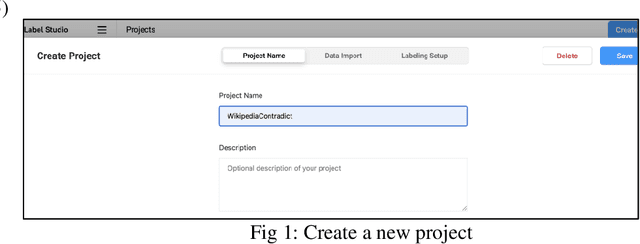
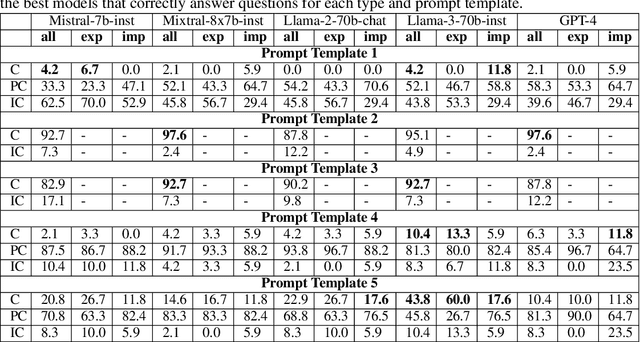
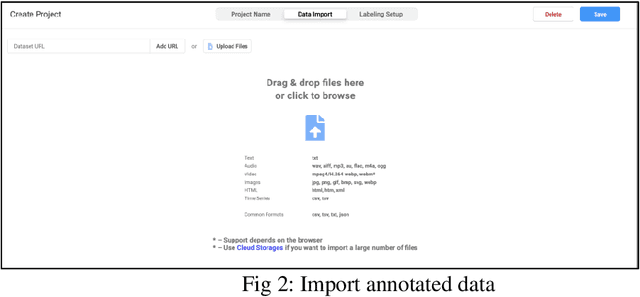
Abstract:Retrieval-augmented generation (RAG) has emerged as a promising solution to mitigate the limitations of large language models (LLMs), such as hallucinations and outdated information. However, it remains unclear how LLMs handle knowledge conflicts arising from different augmented retrieved passages, especially when these passages originate from the same source and have equal trustworthiness. In this work, we conduct a comprehensive evaluation of LLM-generated answers to questions that have varying answers based on contradictory passages from Wikipedia, a dataset widely regarded as a high-quality pre-training resource for most LLMs. Specifically, we introduce WikiContradict, a benchmark consisting of 253 high-quality, human-annotated instances designed to assess LLM performance when augmented with retrieved passages containing real-world knowledge conflicts. We benchmark a diverse range of both closed and open-source LLMs under different QA scenarios, including RAG with a single passage, and RAG with 2 contradictory passages. Through rigorous human evaluations on a subset of WikiContradict instances involving 5 LLMs and over 3,500 judgements, we shed light on the behaviour and limitations of these models. For instance, when provided with two passages containing contradictory facts, all models struggle to generate answers that accurately reflect the conflicting nature of the context, especially for implicit conflicts requiring reasoning. Since human evaluation is costly, we also introduce an automated model that estimates LLM performance using a strong open-source language model, achieving an F-score of 0.8. Using this automated metric, we evaluate more than 1,500 answers from seven LLMs across all WikiContradict instances. To facilitate future work, we release WikiContradict on: https://ibm.biz/wikicontradict.
Functional Graph Convolutional Networks: A unified multi-task and multi-modal learning framework to facilitate health and social-care insights
Mar 27, 2024



Abstract:This paper introduces a novel Functional Graph Convolutional Network (funGCN) framework that combines Functional Data Analysis and Graph Convolutional Networks to address the complexities of multi-task and multi-modal learning in digital health and longitudinal studies. With the growing importance of health solutions to improve health care and social support, ensure healthy lives, and promote well-being at all ages, funGCN offers a unified approach to handle multivariate longitudinal data for multiple entities and ensures interpretability even with small sample sizes. Key innovations include task-specific embedding components that manage different data types, the ability to perform classification, regression, and forecasting, and the creation of a knowledge graph for insightful data interpretation. The efficacy of funGCN is validated through simulation experiments and a real-data application.
Feature Selection for Functional Data Classification
Jan 11, 2024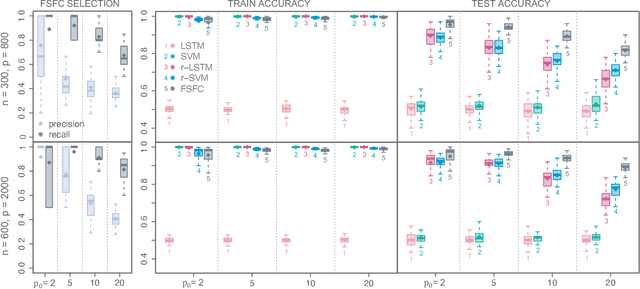
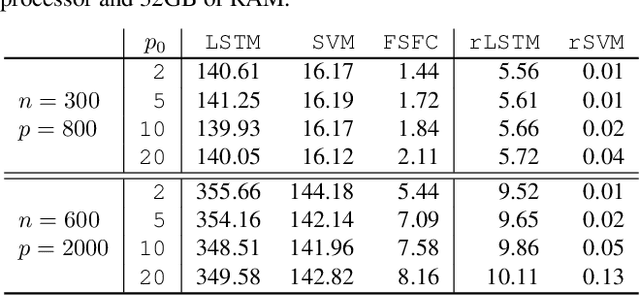
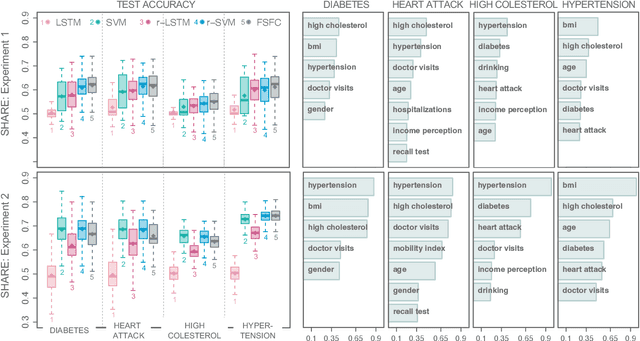
Abstract:Functional data analysis has emerged as a crucial tool in many contemporary scientific domains that require the integration and interpretation of complex data. Moreover, the advent of new technologies has facilitated the collection of a large number of longitudinal variables, making feature selection pivotal for avoiding overfitting and improving prediction performance. This paper introduces a novel methodology called FSFC (Feature Selection for Functional Classification), that addresses the challenge of jointly performing feature selection and classification of functional data in scenarios with categorical responses and longitudinal features. Our approach tackles a newly defined optimization problem that integrates logistic loss and functional features to identify the most crucial features for classification. To address the minimization procedure, we employ functional principal components and develop a new adaptive version of the Dual Augmented Lagrangian algorithm that leverages the sparsity structure of the problem for dimensionality reduction. The computational efficiency of FSFC enables handling high-dimensional scenarios where the number of features may considerably exceed the number of statistical units. Simulation experiments demonstrate that FSFC outperforms other machine learning and deep learning methods in computational time and classification accuracy. Furthermore, the FSFC feature selection capability can be leveraged to significantly reduce the problem's dimensionality and enhance the performances of other classification algorithms. The efficacy of FSFC is also demonstrated through a real data application, analyzing relationships between four chronic diseases and other health and socio-demographic factors.
Information Flow in Graph Neural Networks: A Clinical Triage Use Case
Sep 12, 2023Abstract:Graph Neural Networks (GNNs) have gained popularity in healthcare and other domains due to their ability to process multi-modal and multi-relational graphs. However, efficient training of GNNs remains challenging, with several open research questions. In this paper, we investigate how the flow of embedding information within GNNs affects the prediction of links in Knowledge Graphs (KGs). Specifically, we propose a mathematical model that decouples the GNN connectivity from the connectivity of the graph data and evaluate the performance of GNNs in a clinical triage use case. Our results demonstrate that incorporating domain knowledge into the GNN connectivity leads to better performance than using the same connectivity as the KG or allowing unconstrained embedding propagation. Moreover, we show that negative edges play a crucial role in achieving good predictions, and that using too many GNN layers can degrade performance.
A recommender for the management of chronic pain in patients undergoing spinal cord stimulation
Sep 06, 2023



Abstract:Spinal cord stimulation (SCS) is a therapeutic approach used for the management of chronic pain. It involves the delivery of electrical impulses to the spinal cord via an implanted device, which when given suitable stimulus parameters can mask or block pain signals. Selection of optimal stimulation parameters usually happens in the clinic under the care of a provider whereas at-home SCS optimization is managed by the patient. In this paper, we propose a recommender system for the management of pain in chronic pain patients undergoing SCS. In particular, we use a contextual multi-armed bandit (CMAB) approach to develop a system that recommends SCS settings to patients with the aim of improving their condition. These recommendations, sent directly to patients though a digital health ecosystem, combined with a patient monitoring system closes the therapeutic loop around a chronic pain patient over their entire patient journey. We evaluated the system in a cohort of SCS-implanted ENVISION study subjects (Clinicaltrials.gov ID: NCT03240588) using a combination of quality of life metrics and Patient States (PS), a novel measure of holistic outcomes. SCS recommendations provided statistically significant improvement in clinical outcomes (pain and/or QoL) in 85\% of all subjects (N=21). Among subjects in moderate PS (N=7) prior to receiving recommendations, 100\% showed statistically significant improvements and 5/7 had improved PS dwell time. This analysis suggests SCS patients may benefit from SCS recommendations, resulting in additional clinical improvement on top of benefits already received from SCS therapy.
(Blue) Taxi Destination and Trip Time Prediction from Partial Trajectories
Sep 17, 2015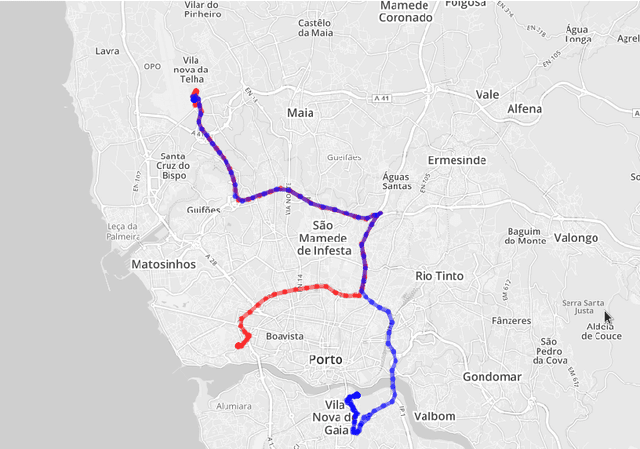
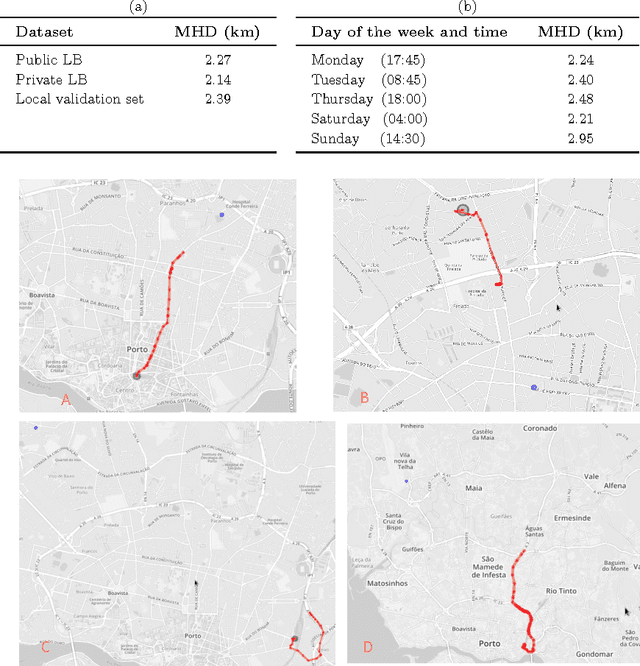
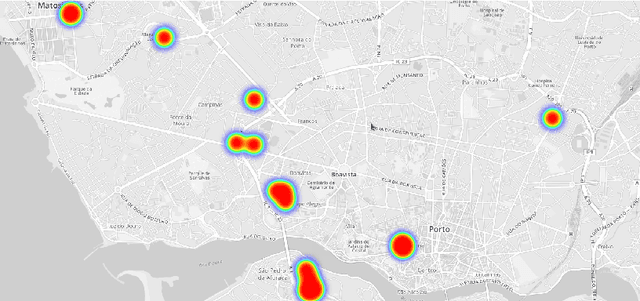
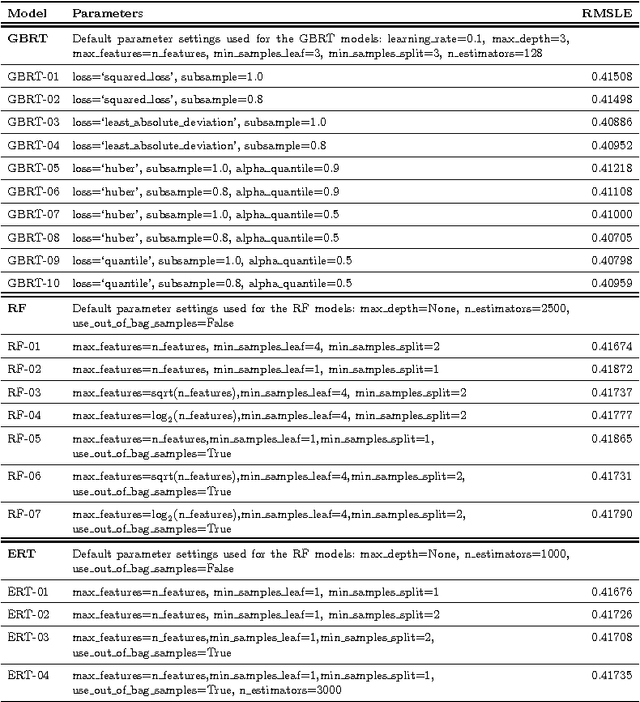
Abstract:Real-time estimation of destination and travel time for taxis is of great importance for existing electronic dispatch systems. We present an approach based on trip matching and ensemble learning, in which we leverage the patterns observed in a dataset of roughly 1.7 million taxi journeys to predict the corresponding final destination and travel time for ongoing taxi trips, as a solution for the ECML/PKDD Discovery Challenge 2015 competition. The results of our empirical evaluation show that our approach is effective and very robust, which led our team -- BlueTaxi -- to the 3rd and 7th position of the final rankings for the trip time and destination prediction tasks, respectively. Given the fact that the final rankings were computed using a very small test set (with only 320 trips) we believe that our approach is one of the most robust solutions for the challenge based on the consistency of our good results across the test sets.
 Add to Chrome
Add to Chrome Add to Firefox
Add to Firefox Add to Edge
Add to Edge